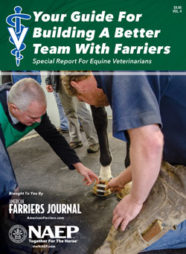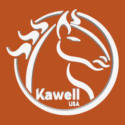
American Farriers Journal is a North American leader in incorporating science and mechanics into the information presented at the International Hoof-Care Summit and in the Journal, says Dr. Jeff Thomason (center), a retired instructor at the University of Guelph. Image: Jeff Cota
In asking “What if American Farriers Journal (AFJ) did not exist?” editor Jeff Cota referenced the value of the life of George Bailey in It’s a Wonderful Life. Another movie came to my mind: The Loneliness of the Long-Distance Runner, because the practice of farriery mostly involves traveling long distances and working alone, once leaving farrier school.
The Journal and the companion International Hoof Care Summit (IHCS) have long provided a continuing link and a forum for exchanging ideas among practitioners of this highly skilled profession.
Not long after the Journal started to expand, someone had the brilliant idea of augmenting skills honed by practice in the field with instruction in a more formal setting for continuing education, and this led to the IHCS.
A second set of brilliant ideas was to incorporate scientific research into the meetings and selected AFJ articles. I was honored to be a speaker at the first IHCS in 2004, at the invitation of Drs. Steve O’Grady and Andy Parks. Steve has the formidable combination of a veterinary degree and credentialled training in farriery. Andy is a dean at the University of Georgia and is well known for his role in developing “The Glass Horse,” computer images of horse anatomy. They had seen some of my published works on the biomechanics and loading of the hoof and lower limb.
Here's a list of topics I covered in the 2004 talk. All are related to the science of motion and mechanics of the lower limb and foot during the stance.
- Impact and force during stance
- Impact – magnitudes of shock
- Impact – frequency analysis
- Force – how the hoof deals with it
- Remodeling – the hoof’s response to changes in loading
Do these topics change the everyday approach of farriers to the foot? Probably not, but they do give an in-depth understanding of the functions of the foot during weight-bearing. The audience was about 400 farriers. I would bet that, despite their daily experience working on horse feet, most of them learned something new that helped them better understand the normal way in which the foot absorbs the immense loads to which it is repeatedly exposed during exercise, and even while standing quietly.

Attendees at the inaugural International Hoof-Care Summit gathered around Dr. Jeff Thomason from the University of Guelph in Ontario (at right), eager to hear more about his research into equine biomechanics.
I was invited back to three more Summits. Later talks went into more detail, for example, on the effects of hoof shape on the loading of the laminar junction and the tendons of the digit. In the most recent presentation, I was honored to accompany Hall of Famer Randy Luikart in giving separate assessments of the motion of the lower limbs in videos of horses with different foot issues.
Having talks at the IHCS given by scientific researchers has continued to this day. That can have only been to the benefit of the farriery industry at large. Each talk is summarized, or reprinted in full, in AFJ, so the information gets to a wider audience than at the Summit.
The AFJ is a leader in North America in incorporating science and mechanics into the information presented at the IHCS gatherings and in the Journal. From the feedback I got from the audiences, there’s a thirst for that kind of knowledge from many farriers. It is possible that other outlets now provide that kind of knowledge, but there is no question AFJ began the process earlier than most.
Read more from "What If American Farriers Journal Didn't Exist?"
What do you think? Where would the farrier industry be if American Farriers Journal never came to be? Share your thoughts by emailing jcota@lessitermedia.com.







